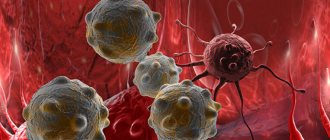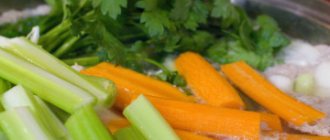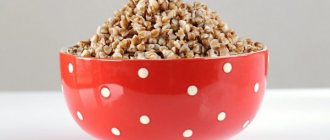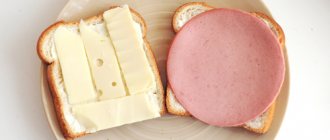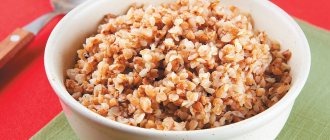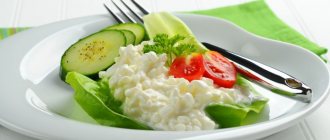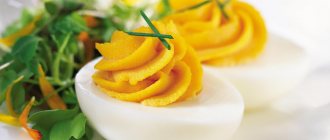“Space diet” by Sergei Sivokho: without denying himself anything, the comedian lost 42 kg in 3 months
Based on many years of research and searches for effective treatment methods, oncologist Laskin created an effective anti-cancer diet based on strong natural oxidants obtained from cereal plant fibers. When creating an anti-cancer technique, Dr. Wolf Laskin left buckwheat, rich in a unique complex - quercetin .
It is able to remove free radicals from the body and restore disrupted processes in the body of a sick person. Another cleansing technique for losing weight is a slag-free diet.
The world's leading institutions have become interested in the unique method of anti-cancer healing, so it is actively practiced among many doctors. Despite the high percentage of effectiveness of the buckwheat treatment method, unfortunately, it does not cure the last two stages of cancer, but only improves the patient’s well-being.
Rules for following the Laskin diet:
1. Eliminate all canned food from your diet. 2. Avoid fried and boiled vegetables. 3. Eat fruits and vegetables fresh, since only in their raw form can they retain the maximum amount of vitamins and nutrients. Red and green vegetables are especially beneficial. 4. Drink at least two liters of liquid (water and tea) per day. 5. Calculate the amount of dietary fiber and fiber consumed.
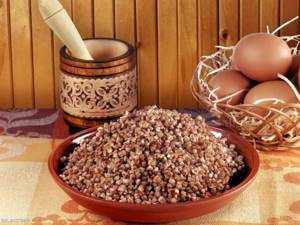
It is important that fats in your diet make up a maximum of 10% of the calorie content of the food consumed. Moreover, they must be exclusively of plant origin.
The amount of protein per day for women should not exceed 40 grams, and for men - 60 grams.
Replace sugar with dried fruits or a small amount of natural honey. Occasionally consumption of milk and dishes with its addition is allowed. Laskin's anti-cancer diet has positive reviews.
Is green buckwheat proven to treat cancer?
From the perspective of evidence-based medicine, the consumption of foods with antitumor effects, including buckwheat, does not have statistically confirmed data on the effectiveness and recovery from such nutrition. However, the fact of the negative impact of buckwheat antioxidants on cancer cells is not disputed.
It is necessary to understand that diet therapy alone is not enough to defeat cancer, especially when it comes to severe cancer patients. However, it is impossible to ignore the principles of proper and healthy nutrition, since an erratic diet, consumption of animals and cooking fats reduces immunity and slows down the recovery process.
Green buckwheat for oncology can be recommended by a specialist in combination with basic treatment methods.
First stage of the diet
Dr. Laskin's anti-cancer diet, whose doctors' reviews are mostly positive, implies a duration of compliance with the first stage of 3 to 4 weeks, but it can also be extended for another couple of weeks. Laskin's buckwheat diet recipes are quite simple. For example, in the morning and lunchtime meals you will have to consume a special mixture of rose hips:
- Dissolve one tablespoon of flour in half a glass of water.
- Then add one small spoon of flower honey to the glass.
- You need to eat porridge half an hour before breakfast and lunch.
For breakfast and subsequent meals, you should eat buckwheat:
- Pour half a glass of cereal into 0.5 liters of water.
- Wait until the water boils.
- Cook for 15 minutes.
- Finally, add one tablespoon of fiber.
- Season with olive oil (2 tbsp).
An hour after your morning meal, Dr. Laskin’s buckwheat diet recommends eating a small handful of raisins and drinking a glass of green tea. Don’t forget about freshly squeezed juices, dilute them with clean water.

Does buckwheat help against cancer?

The diet of Dr. Wolf Laskin is based on the inclusion in the diet of natural food components that have an oncoprotective effect. A similar therapeutic effect is characteristic of quercetin - it is a flavonoid from the group of vitamins P.
Buckwheat contains quercetin in increased quantities - 24 g per 300 g of cereal. According to Dr. Laskin, long-term or lifelong consumption of large portions of buckwheat can affect the course of the disease and stop the development of a cancerous tumor.
For reference. The record holder for quercetin content is rose hips (up to 11.5% of the norm in 100 g). In second place is buckwheat (about 8%), and in third place is onion peel (up to 4%).
It is difficult to say how effective buckwheat is against cancer. It is difficult to assess its effect, since most patients receive complex treatment, and the effect may be associated with the action of a number of medications.
There is no doubt that buckwheat serves as an effective means of preventing cancer due to its powerful antioxidant properties. However, on the Internet you can find positive reviews of women who used the Laskin diet for breast cancer, and they managed to achieve stable remission.
How
The basis of the author’s method of treating cancer according to Laskin is a nutritional system aimed at consuming large doses of quercetin contained in buckwheat. Quercetin is directly involved in restoring the functions of the p53 gene in cancer cells, mutation of which occurs in almost all cases of cancer. Its deficiency causes cancer in 50-60% of the total number of cases.
Quercetin, in turn, affects the p53 gene and rehabilitates it, which leads to a decrease in the degree of differentiation of cancer cells. Quercetin also neutralizes the effects of dangerous free radicals, inhibits the inflammatory process, and increases the defense of the immune system.
What is the secret of the healing effect of buckwheat?
According to Dr. Laskin, consuming buckwheat can successfully resist the growth and formation of new cancer cells, since its grains contain high concentrations of quercetin.
This natural biochemical substance is endowed with various medicinal properties:
- Antioxidant. Neutralizes the effect of free radicals and other dangerous substances on the body, suppresses oxidation processes.
- Capillary stabilizing. Increases the stability of capillary walls, reduces the permeability of vascular walls, improves microcirculation, and normalizes venous outflow.
- Anti-inflammatory. Blocks the synthesis of inflammatory mediators, inhibits the activity of existing inflammatory processes.
- Cardioprotective. Stimulates the energy supply of cardiac muscle cells.
- Radioprotective. Reduces the effects of gamma and x-ray radiation.
- Immunomodulatory. It has an effect on the immune system, activates immunocompetent cells, increases resistance to the action of pathogenic microorganisms.
Other properties of quercetin have been experimentally determined: antispasmodic, regenerative, diuretic, anti-sclerotic, antihistamine. Flavonoids are also able to regulate blood pressure, increase insulin secretion, change the activity of many metabolic enzymes, and slow down the aging process.
Thus, with regular consumption of buckwheat and the exclusion of “harmful” foods, quercetin, entering the body, affects the activity of cancer cells by suppressing enzymatic reactions. The degenerated cancer cell does not receive protein molecules important for maintaining life, and therefore its life expectancy is reduced.
Advice. It is recommended to consume buckwheat especially actively and in large quantities during radiation or chemotherapy, since the beneficial components of the cereal protect cell membranes from the toxic effects of chemicals and medications.
Sample menu for the Laskin diet
Monday, Wednesday and Saturday:
- first breakfast - porridge made from rosehip powder (grind 100 grams of dried rosehip using a coffee grinder, pour 1 tablespoon of the resulting powder with a small amount of chilled water and mix with 1 tablespoon of honey to make a porridge);
- second breakfast - a cup of fresh blueberries (on Monday), a little pineapple (on Wednesday and Saturday);
- before lunch - porridge made from rosehip powder;
- lunch - a portion of fresh vegetable salad, some salmon, legume soup (on Monday), mushroom soup (on Wednesday and Saturday);
- dinner - any nuts, 80 grams of raisins, a portion of stewed vegetables, a cup of green tea without sugar.
Tuesday and Thursday:
- first breakfast - porridge made from rosehip powder;
- second breakfast - two slices of bread, up to 100 grams of raisins, a cup of green tea and a portion of oatmeal without salt and sugar;
- before lunch - porridge made from rosehip powder;
- lunch - vegetable salad, lentil soup, steamed chicken;
- any nuts, a portion of stewed vegetables, a cup of green tea.
Friday and Sunday:
- before breakfast - porridge made from rosehip powder;
- first breakfast - two slices of bread, up to 100 grams of raisins, a portion of rice porridge;
- second breakfast - a cup of blueberries (on Friday), a little pineapple (on Sunday);
- before lunch - porridge made from rosehip powder;
- lunch - fresh vegetable salad, chicken, lentil soup;
- dinner - about 80 grams of raisins, a portion of stewed vegetables, a cup of green tea.
Red bell peppers, Brussels sprouts, broccoli, beets, carrots and pumpkin are perfect for stewed vegetables. Vegetables should be stewed in water with vegetable oil (no more than 1 tbsp.).
Chicken can be either steamed or stewed. You can add onions, ginger, orange zest, white wine, etc. to it. Below you can read reviews from those who have tried Dr. Laskin's diet.
What do representatives of official medicine think about this method?
Reviews from specialists about Dr. Laskin's anti-cancer diet are few . Most experts question the author’s assertions that the results of consuming “loading doses” of buckwheat are the death of cancer cells, and the tumor completely disappears .
In addition, according to European Food safety (EFSA, 2011), there are no scientific studies that confirm any therapeutic effect of quercetin. It is not registered as a separate drug for the treatment of any diseases, including malignant tumors.
According to most nutritionists and oncologists, we can talk about the general healing effect of buckwheat for the body, and use it as a therapeutic food for people suffering from diabetes, hypertension, coronary heart disease, atherosclerosis and other diseases that increase the risk of developing cancer.
Proponents of a healthy diet agree with Dr. Wulf Laskin that the diet should contain exclusively natural products: grains, vegetables, fruits, garden herbs, dairy and fermented milk products, vegetable and fruit juices. Instead, it is recommended to completely exclude concentrated fish and meat broths, mushrooms, legumes, potatoes, red meat, alcohol, sugar and products containing it from the diet.
What is the secret of the healing effect of buckwheat?
According to Dr. Laskin, the healing effect of buckwheat porridge against cancer is due to the intake of a reduced amount of protein into the body (and this protein is vegetable) and the high content of quercetin in buckwheat.
Low protein diet - the basis of nutrition for cancer
Many studies by Western scientists emphasize the need to significantly reduce the amount of animal protein and fat in the diet of patients with malignant tumors. For example, there is a hypothesis that cancer cells intensively use arachidonic acid for their development, which is found in large quantities in animal products - meat and offal, milk fat, eggs.
The negative effect on the heart and blood vessels of excess cholesterol contained in these same foods has been confirmed by numerous studies. Therefore, it is important to limit the amount of animal protein in food, trying instead to consume vegetable protein found in legumes and cereals (including buckwheat), nuts and seeds. Most of the animal fat (fatty meat and lard, butter, cheese and sour cream) must be replaced with vegetable oil - olive, flaxseed, rapeseed.
According to Dr. Laskin, it is enough to consume 40-50 g of protein per day for women and 60 g for men of mental work. The maximum percentage of fat in the daily diet is no more than 30% (and 80% of fat comes from vegetable oils), and ideally only 10%. Based on these principles, you can create a rough healthy eating plan for each person. Unfortunately, most of us exceed these standards by 3-5 times or more. Many health problems arise precisely from such poor nutrition with excess animal fats and proteins. As for cancer patients, the above norms of protein and fat intake are mandatory for them, and exceeding them often leads to relapses of the disease.
By the way, in accordance with the recommendations of the World Health Organization (WHO), the minimum protein intake is approximately 0.5 g per kilogram of weight per day, and the optimal norm is 0.7-0.8 g/kg of weight. Everyone can calculate their own intake depending on body weight and knowing the protein content in food.
Quercetin against cancer
It is assumed that quercetin, contained in buckwheat porridge, activates the protein (phosphoprotein) p53, which regulates cell division processes, promotes the restoration of damaged DNA sections, and if such restoration is impossible, destroys the diseased cell, including cancer cells. In addition, quercetin, as well as antioxidants contained in whole grains, legumes, rose hips, vegetables and fruits, increase the body's defenses and immune defense.
By the way, surgery, tumor irradiation, and chemotherapy reduce the functionality of the p53 protein and the gene that controls the functioning of this protein. Therefore, a strict buckwheat diet during the acute period of illness helps neutralize the side effects of treatment and helps the body cope with the disease.
2 buckwheat porridge recipes from Dr. Laskin
- Pour 2 cups of water into a saucepan and add half a cup of buckwheat. The porridge is cooked for 20-25 minutes; 5-7 minutes before the end of cooking, add one tablespoon of wheat bran to the porridge. Add 1-2 tablespoons of extra virgin olive oil to the finished porridge.
- Buckwheat, lentils and rose hips are taken in equal quantities, ground in a coffee grinder, and sifted. In the morning, 15-30 minutes before breakfast, two tablespoons of the resulting flour are diluted in a small amount of boiled water and the resulting gruel is eaten
Strict buckwheat diet for cancer
Oncologist Laskin recommends this nutritional system during the period of exacerbation of the disease, when the state of health is seriously impaired, there is a risk of tumor metastasis, in the postoperative period, during courses of radiation and chemotherapy. The duration of a strict buckwheat diet ranges from 1 to 3-4 months. During this time, the patient takes freshly prepared buckwheat porridge with olive oil 3 times a day. In addition, you need to drink 5-8 glasses of liquid. This is mostly water (you can include in this amount 1-2 glasses of diluted freshly squeezed juice - fruit, vegetable or a mixture of both). Salt can be added to porridge in an amount of no more than 0.5 g per day. In the future, with a significant improvement in the condition and a lasting positive effect recorded by doctors (reduction of the tumor, absence of metastases), you can move on to the expanded version of the buckwheat diet described below.
Does the buckwheat diet help against cancer?
In any case, using buckwheat to strengthen the body and increase its defenses has at least several advantages:
- The diet was developed by an oncologist with 30 years of experience
- Taking buckwheat porridge cannot harm the body, but there is a chance to improve your well-being and successfully fight a serious illness
- The benefits of buckwheat porridge have been noted not only for cancer, but also for a number of chronic diseases of the cardiovascular system, gastrointestinal tract, urinary tract, and obesity
- During the use of the anti-cancer diet, many positive reviews from patients with cancer appeared
Examples of healing after applying a strict buckwheat diet (from the book “Anti-Cancer Diet by Dr. Laskin” 2006):
- Patient S., 34 years old. Stage III left breast cancer. I came in after a radical mastectomy (removal of the gland) and radiotherapy. She underwent a course of chemotherapy and maintained a 100% grain diet for 3 years. Subsequently, I excluded salt from the diet (only 0.5 grams per day), sugar, and animal proteins. She was examined for 16 years: no metastases appeared
- Patient M., 38 years old. Stage IV right breast cancer, metastases to the lung. The patient was switched to a 100% diet based on cereal plants. Three months later, during a follow-up examination, no metastases in the lungs were detected.
- Patient K., 15 years old, lymphogranulomatosis with damage to the lymph nodes above and below the diaphragm. Six courses of chemotherapy had no effect - the lymph nodes became enlarged. The patient was switched to a 100% buckwheat diet and had another chemotherapy session. The patient was on a diet for 24 weeks. Three years later she got married and gave birth to two daughters. Examination 15 years after treatment: no relapse of lymphogranulomatosis was detected
- Patient M., 38 years old. Stage IV right breast cancer, metastases to the lung. The patient was switched to a 100% cereal diet. Three months later, during a follow-up examination, no metastases in the lungs were detected
- Patient I., 58 years old. Prostate cancer with metastases to the pelvic bones, with invasion into the urethra. Severe pain when urinating. When switched to a cereal diet, the pain syndrome was relieved after 7 days. The patient lived without pain for 3 years
- Patient M., 63 years old. Stage II right breast cancer. Complex treatment. After 9 years, metastases were discovered in the 12th thoracic vertebra with a compression fracture and compression of the spinal cord, flaccid paralysis of both lower extremities. The patient was prescribed a cereal diet and treatment with the position of lying on her back on a wooden board. After 6 weeks, the patient stood on crutches and walked. And a year later I came to see a doctor on public transport
